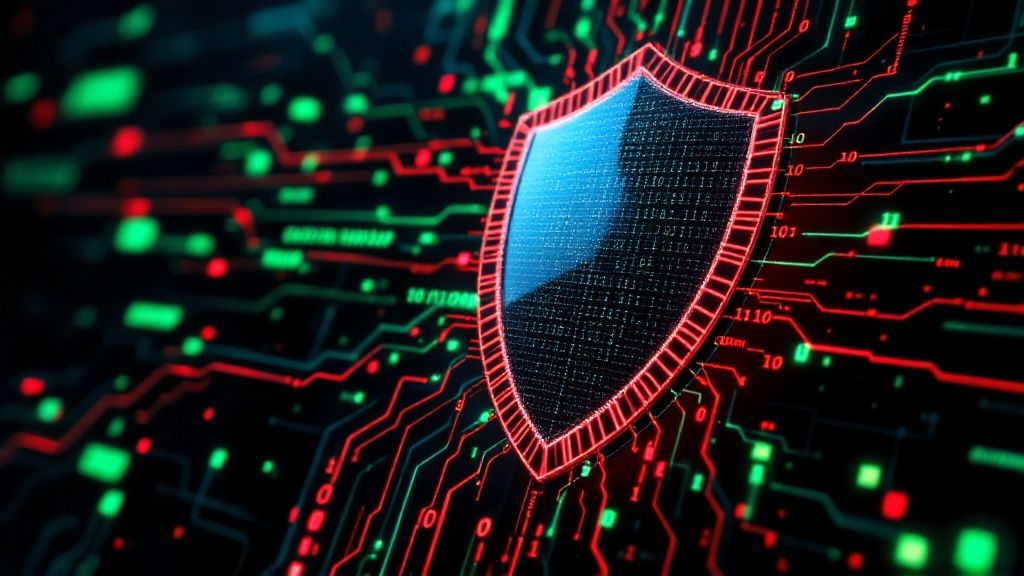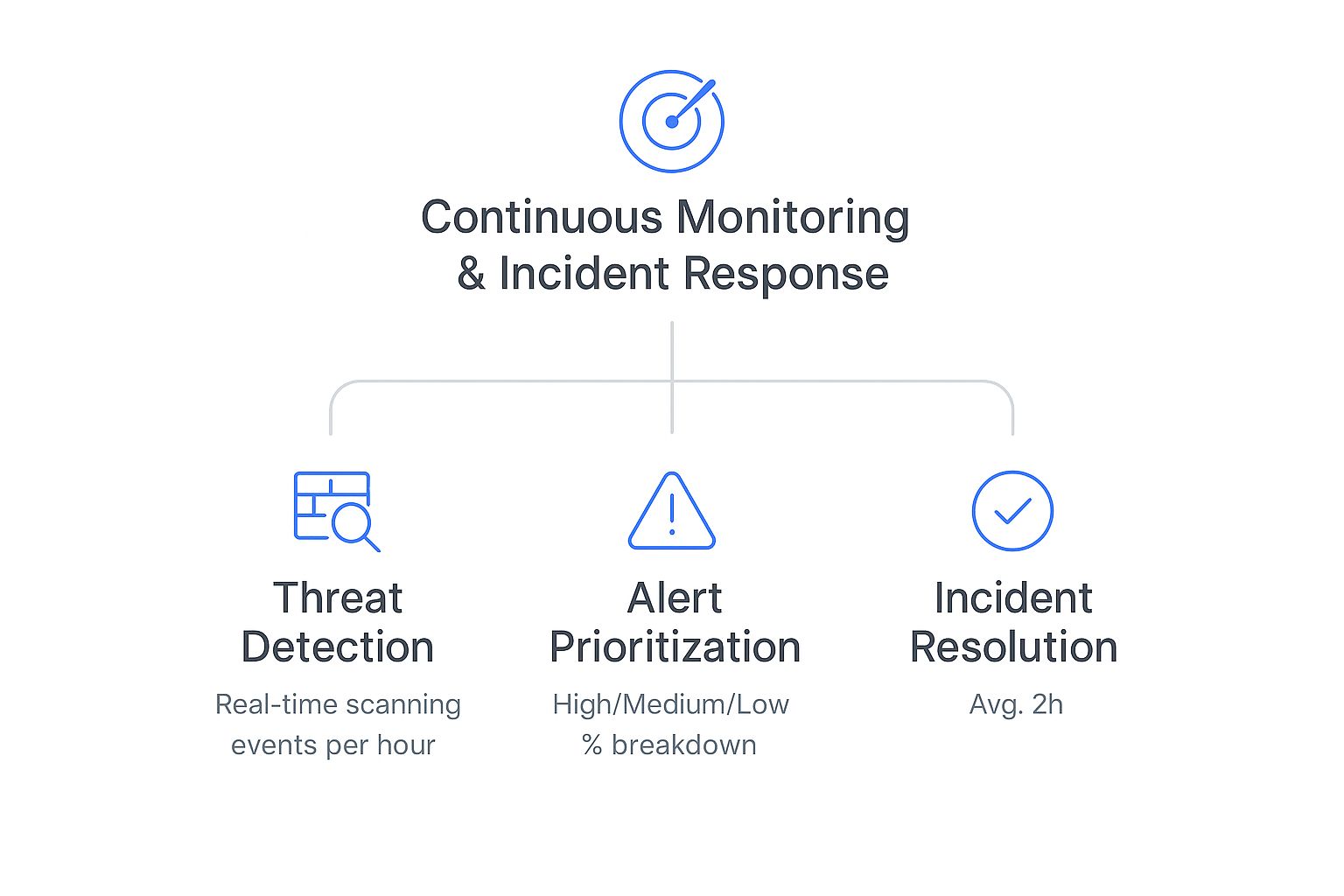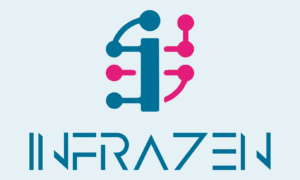When someone talks about cyber security solutions, they're talking about the entire collection of tools, strategies, and day-to-day practices a business uses to shield its digital assets from theft, damage, or prying eyes.
Think of it less as a single product and more as a complete security system for your company's online world, built from multiple layers of defence. It’s a proactive stance, and frankly, it's essential for survival and growth today.
Unpacking What Cyber Security Solutions Really Mean

To really get your head around cyber security solutions, picture your business's online operations as a physical headquarters. You wouldn't just rely on a single lock on the front door to protect everything inside, would you? You’d have a proper security plan.
That's exactly how a strong digital defence works. It’s not about buying one magic piece of software, but about creating a coordinated system where different elements work in concert to protect the whole operation.
Some of these tools act like the heavy-duty locks and reinforced windows for your digital office. Others are more like security guards, actively monitoring the CCTV cameras for anything that looks out of place.
The Layers of Digital Protection
To build a defence that can actually withstand an attack, you need multiple layers that cover different potential weaknesses. This multi-faceted strategy ensures that if one layer is somehow bypassed, another is right there, ready to stop the threat dead in its tracks. It's worlds more effective than putting all your eggs in one basket.
Key components of this layered approach usually include:
- Perimeter Defence: This is your first line of defence, like the outer walls of a fortress. Firewalls and secure network gateways act as the gatekeepers, controlling who and what gets in or out of your network.
- Access Control: Just as you’d use keycards to restrict access to sensitive rooms, identity management systems make sure only authorised people can get to specific data and applications. It stops unauthorised users from wandering into critical areas.
- Active Monitoring: This is your digital security team, constantly watching for threats. Threat detection and response systems scan for unusual behaviour and neutralise dangers before they can cause real harm.
A common misconception is that cyber security is a purely technical problem solved by buying software. In reality, it is a business-risk issue that requires a strategic, multi-layered solution combining technology, processes, and people to protect critical assets.
The Urgent Need for a Proactive Defence
The need for robust cyber security isn't just theory-it's a pressing reality for businesses of every size. Threats aren't just becoming more frequent; they're getting smarter and more disruptive.
In the UK, a staggering 43% of all businesses reported a breach in the past year, and that figure climbs to 74% for large firms. Phishing remains a dominant threat, which really highlights the need for a defence that accounts for human error, not just technical gaps.
Understanding how these attacks happen is the first step toward building an effective shield. Our guide on how to prevent a cyber attack walks you through the practical steps for creating a more secure business environment. By implementing a complete strategy, you shift from reacting to problems to proactively preventing them, safeguarding your data, your clients' trust, and your future.
Why Creative Teams Face Unique Digital Risks

Creative agencies and design studios aren't like other businesses. They are guardians of imagination and innovation, and the assets they create aren't just files on a server. They're confidential client strategies, unreleased campaign materials, and proprietary designs worth a fortune.
This concentration of high-value intellectual property makes creative teams a prime target for cyber attacks. The very work that defines their brand and drives their revenue is the exact data that attackers are desperate to steal or hold for ransom.
Picture a design agency just days away from a major client launch. Suddenly, a ransomware attack encrypts every project file, every client proof, and every strategic document. The launch is dead in the water, deadlines are shattered, and the client relationship is instantly broken. This isn't a far-fetched nightmare-it's a real and growing threat.
The High Stakes of Intellectual Property Theft
For a creative business, losing intellectual property (IP) can be far more damaging than direct financial theft. If a competitor gets their hands on a groundbreaking campaign concept before it goes public, it could destroy months of work and wipe out a hard-won competitive advantage in an instant.
The fallout from a breach goes way beyond a single project. The consequences are often immediate and severe:
- Financial Collapse: The cost of downtime, recovery efforts, and potential ransom payments can be crippling, especially for smaller studios.
- Reputational Ruin: Clients trust agencies with their most sensitive plans. A publicised breach signals that this trust was broken, driving away current and future business.
- Legal Complications: Failing to protect client data can lead to serious legal action and regulatory fines, adding another layer of financial strain.
This is why having robust cyber security solutions in place isn't just an IT expense. It’s a fundamental pillar of business continuity and client trust.
Vulnerabilities in the Creative Workflow
Creative workflows are naturally collaborative, often involving a constant exchange of large files and sensitive data with external partners like freelancers, clients, and vendors. Each exchange, if not managed securely, creates a potential entry point for an attacker.
On top of that, creative professionals rely on a wide array of specialised software and cloud services. Every one of these tools represents another potential vulnerability that needs to be properly secured and monitored. A simple weakness in one piece of software could compromise the entire operation.
That makes it vital to regularly assess your security posture. To get started, you can find out more by exploring our guide that asks what is a vulnerability assessment and why it's so important for modern businesses.
The core danger is that a creative team’s most valuable assets are entirely digital. Unlike physical goods, intellectual property can be copied and distributed globally in seconds, making its protection an absolute priority.
Without a dedicated security strategy, creative teams are operating with a level of risk that threatens their very existence. They’re protecting more than just data-they are safeguarding their ideas, their clients' futures, and the creative work that sets them apart. A proactive approach isn't just recommended; it's the only way forward.
Exploring the Core Categories of Cyber Protection
To build a solid defence, you first need to understand the battlefield. The world of cyber security solutions can feel overly complex, but it all starts to make sense when you break it down into four foundational pillars: Network Security, Cloud Security, Endpoint Security, and Application Security.
Thinking in these categories helps you see your business's security as a complete, interconnected system. It's the difference between having a coherent strategy and just a random collection of software, allowing you to spot weaknesses and see how everything fits together.
Fortifying Your Network Perimeter
Think of network security as your digital perimeter fence. Its primary job is to control who and what gets access to your internal network, stopping unauthorised users and malicious traffic long before they get anywhere near your important data. It is your first line of defence against outside threats.
The most common tools for this job include:
- Firewalls: These are the gatekeepers. They inspect all incoming and outgoing traffic, blocking anything that doesn’t meet a strict set of security rules.
- Virtual Private Networks (VPNs): A VPN creates a secure, encrypted tunnel for data to travel through. This is especially vital for remote workers accessing the company network from outside the office.
- Intrusion Detection Systems (IDS): These systems are your digital watchdogs, actively monitoring network traffic for suspicious activity or policy violations and alerting you to potential threats in real time.
By setting up a strong network perimeter, you create a controlled environment where your digital assets are much better protected from a huge range of external attacks.
Securing Your Cloud Environment
As more creative work moves onto cloud platforms, securing these online spaces has become absolutely critical. Cloud security is simply the combination of policies, controls, and tech designed to protect data, applications, and infrastructure hosted in the cloud.
Responsibility for this is often shared between you and the cloud provider, like Amazon Web Services or Microsoft Azure. But make no mistake, your business is ultimately on the hook for securing its own data and controlling who can access it within the cloud. That means getting access controls configured correctly and keeping an eye out for unusual behaviour that might signal a compromised account.
A common mistake is assuming the cloud provider handles all security. While they secure the underlying infrastructure, you are responsible for securing what you put in the cloud-your data, applications, and user access configurations.
Protecting Every Endpoint Device
An endpoint is any device that connects to your corporate network. We're talking laptops, smartphones, tablets, and servers. Each one is a potential entry point for an attack, which makes endpoint security one of the most vital parts of any modern defence strategy.
This is basically the armour for your individual devices. Since your team often uses these devices outside the protected company network, they're prime targets for phishing attacks and malware. Robust endpoint protection isn't negotiable. It means deploying software that can detect, prevent, and respond to threats right on the device itself. To get a clearer picture, it's worth exploring the key features of a modern managed endpoint detection and response service.
The infographic below shows how a continuous monitoring and response process works to protect these endpoints and the wider network.

This process visualises a structured approach, kicking off with real-time threat detection, then moving to intelligent alert prioritisation, and finally aiming for rapid incident resolution to keep any damage to a minimum.
Shielding Your Applications and Data
Finally, application security focuses on protecting the software your business relies on every day. This covers everything from off-the-shelf programs to custom-built applications, ensuring they can't be exploited by attackers. Vulnerabilities in software code are a common backdoor for criminals looking to access sensitive information.
This involves good habits like secure coding, regular security testing, and patching known vulnerabilities the moment fixes become available. It ensures the applications themselves don’t become the weak link in your security chain.
Hand-in-hand with application security is securing your data at its source. While looking at these core categories of cyber protection, it's crucial to also discover essential database management best practices to safeguard your digital assets effectively. By understanding and addressing these four pillars, you can build a layered defence that protects your creative business from every angle.
How to Choose the Right Security Partner for Your Business

Picking a provider for your cyber security solutions is one of the biggest decisions you'll make. The right partner becomes a silent extension of your team, protecting your assets while you focus on creative work. The wrong one? They can create friction, introduce new risks, and let you down when it matters most.
For a creative business without a dedicated security expert on staff, the choice can feel overwhelming. But you don't need to be a technical wizard to make a smart decision. It's really about asking the right questions and focusing on outcomes, not just flashy tech specs.
A good partner will do more than just sell you software. They’ll take the time to understand your unique creative workflows, the immense value of your intellectual property, and where your business is headed.
Evaluating Scalability and Integration
Your business isn't going to stand still, and your security partner needs to keep up. A solution that works perfectly for your five-person studio today could become a major roadblock when you expand to a team of twenty. Scalability has to be on your radar from day one.
Ask potential partners how their services adapt as you grow. Can they easily add new users, protect new devices, and expand their coverage without a fuss? A flexible model saves you from the nightmare of ripping everything out and starting over in a couple of years.
Just as important is how their solutions play with your existing tech. A creative agency lives and breathes a specific set of tools-from project management software to large file transfer services. A security solution that clashes with these will slow your team down and force frustrating workarounds, completely defeating the purpose.
The best security solutions empower your team, they don't create roadblocks. A true partner ensures security becomes a seamless part of your operations, enabling productivity and protecting your work without causing friction.
Assessing Support and Proactive Defence
When a security incident hits, the only thing that matters is the quality and speed of your provider's support team. You can't afford to wait for a crisis to discover their response is slow or unhelpful. You need to dig into their support structure during the evaluation process.
Ask them the tough questions about their incident response:
- What are your guaranteed response times? You need to know exactly how quickly you can expect help.
- Who will I be speaking to? Will you get a dedicated expert, or will you be stuck in a generic call centre queue?
- What is your process for managing a breach? A clear, documented plan is a sign they are prepared for a worst-case scenario.
Beyond just reacting to problems, look for a partner that focuses on proactive threat hunting. This is the practice of actively searching for hidden threats within your network instead of just waiting for an automated alert. It’s the difference between a security guard who only watches the front door and one who patrols the entire building, checking for unlocked windows and hidden dangers.
Looking for Industry-Specific Expertise
The UK is a powerhouse for security innovation. The sector generates £13.2 billion in revenue, and investment in dedicated firms recently hit around £206 million across 59 deals. With thousands of firms out there, you can afford to be selective and find one that truly gets your world. You can read more about the UK's strong cyber security sector on GOV.UK.
For creative businesses, this kind of expertise is non-negotiable. A partner who understands the high value of unreleased campaign files or proprietary designs will provide far more relevant and effective protection. They'll get your unique risks and workflows, offering advice that makes sense for how you actually work.
For a deeper dive, our cyber security consulting service is designed to help creative teams navigate these exact challenges. Finding the right fit isn't just about ticking boxes; it's about building a long-term partnership based on trust, expertise, and a shared understanding of what you’re trying to protect.
A Unified Approach to Modern Cyber Defence
Relying on a patchwork of individual security tools is like trying to guard a fortress with disconnected alarm systems-one for the gate, another for the walls, and a third for the vaults. If they can’t talk to each other, you’re left with dangerous gaps. A modern, integrated approach to cyber security solutions moves past this fragmented, and frankly outdated, model.
Think of a unified platform as your central command centre. It pulls threat detection, incident response, and continuous monitoring together into one manageable service. This integration gets rid of the complexity and blind spots that pop up when you’re juggling a dozen different products from different vendors.
For creative teams, the benefits are obvious right away. Instead of being swamped with hundreds of meaningless alerts from various tools, you get a single, clear view of the threats that actually matter. Management gets simpler, the oversight is handled by experts, and you gain the confidence that your entire operation is being watched over cohesively.
Proactive Defence in Action
A unified security system works on a simple principle: stop incidents before they cause real damage. It’s not about waiting for a problem to hit and then cleaning up the mess. It's about proactively spotting and neutralising threats at the earliest possible stage.
This proactive stance is built on a few key functions working in harmony:
- Continuous Monitoring: The system keeps a constant watch over your entire network-endpoints, cloud services, and applications-looking for any hint of suspicious activity. It’s like having a security patrol that never sleeps.
- Intelligent Threat Detection: Using advanced analytics, the platform can tell the difference between normal business activity and the subtle signs of an attack. This intelligence is crucial for spotting sophisticated threats that might otherwise fly under the radar.
- Automated Incident Response: When a credible threat is detected, the system can take immediate, automated action. This could mean isolating an affected device from the network to stop a threat from spreading, all before a human analyst even needs to step in.
This coordinated defence means your team isn't constantly being pulled away from their real work. They’re free to focus on their creative projects, confident that a robust system is working behind the scenes to protect them.
A unified security platform shifts the focus from reactive problem-solving to proactive threat prevention. It’s not just about having the tools-it’s about making them work together as a single, intelligent system to stop attacks before they disrupt your business.
Streamlining Security for Creative Workflows
The real power of a unified approach is how it simplifies protection without cutting corners on strength. Juggling multiple security dashboards and trying to make sense of conflicting alerts is a recipe for confusion and, inevitably, missed threats. A single, integrated service solves this.
Let's say a designer downloads a file from a new client. A unified system doesn’t just scan it for malware. It also checks the sender's reputation, analyses the file's behaviour in a safe, sandboxed environment, and logs the activity as part of the bigger picture. This holistic view gives you a level of protection that individual tools just can't match on their own.
Ultimately, this unified model of cyber security solutions gives creative teams what they need most: peace of mind. It ensures their valuable intellectual property is protected by an intelligent, always-on defence system, allowing them to create, innovate, and collaborate without constantly looking over their shoulders.
Preparing for the Future of Cyber Threats
The world of cyber threats never stands still. Attackers are always refining their methods, which means staying put is the fastest way to get left behind. We can't just react to what's happening now; we need to anticipate what’s coming next. It's about looking over the horizon to understand the trends that will shape tomorrow's security challenges.
One of the biggest game-changers is Artificial Intelligence (AI), and it’s a double-edged sword. On one side, attackers use AI to craft frighteningly convincing phishing emails and malware that can literally change its own code to avoid being caught. But on the other, AI is also what powers the next wave of defensive cyber security solutions-tools that can analyse vast amounts of data to predict an attack before it even happens.
These smart systems learn the rhythm of your network, figuring out what's normal so they can instantly spot anything that looks out of place. Instead of just reacting to a fire, they can proactively snuff out the spark automatically.
Adapting to New Work Environments
The shift to remote working has permanently redrawn the map of how and where business gets done. While it offers incredible flexibility, it has also opened up a whole new set of vulnerabilities. With team members accessing sensitive company files from home networks-which rarely have the same level of security as the office-your business's attack surface has grown massively.
Add to that the explosion of Internet of Things (IoT) devices, and you’ve got another layer of complexity. Every smart gadget in your office, from the printer to the thermostat, is a potential doorway for an intruder if it’s not properly locked down.
The future of security isn't about building one single, impenetrable wall. It’s about creating an adaptive, intelligent defence that can protect a distributed and dynamic workforce, no matter where they are or what devices they use.
Evolving Threats and Government Response
It’s not just businesses taking notice. Governments are stepping up their game in response to these growing challenges. The UK government's recent Spending Review, for example, pledged an additional £0.6 billion to the Single Intelligence Account, a clear sign of its commitment to boosting national cyber capabilities. You can get more details on the UK's investment in cyber security and intelligence modernisation on industrialcyber.co.
This national focus underscores why every organisation needs to be prepared. A crucial part of that preparation is having a solid strategy in place before something goes wrong, and a comprehensive security incident response planning guide is an invaluable tool for this. The goal is to build a defence that is as fluid and forward-thinking as the threats themselves, making sure your business stays protected for the long haul.
Your Cyber Security Questions Answered
Diving into the world of cyber security solutions can feel a bit overwhelming, especially when your focus is on creative work, not tech. Let’s clear up some of the most common questions with straightforward answers to help you protect your business.
Do We Really Need a Full Security Solution as a Small Business?
Yes, you absolutely do. It's a common myth that attackers only go after big corporations. In reality, smaller businesses are often prime targets precisely because hackers assume their security is weaker.
A single data breach-whether it’s stolen client files or a ransomware attack that locks you out of your work-can be devastating for a small agency’s finances and the reputation you’ve worked so hard to build. Modern solutions are designed to be affordable and scale with you, making top-tier protection accessible for everyone, not just the big players.
What’s the Difference Between Antivirus and a Complete Solution?
This is a really important distinction. Think of antivirus as a lock on one door in a building full of unlocked windows. It's a single tool that mainly spots and removes known malware from one device at a time. It’s a start, but it’s not enough.
A complete cyber security solution is a whole strategy. It includes antivirus, of course, but it also adds firewalls, email protection, continuous threat monitoring, and data encryption into the mix.
A complete solution is designed to protect your entire business network and all its moving parts-not just one computer from one type of threat. It’s a comprehensive defence system, whereas antivirus is just one piece of the puzzle.
This layered approach shields your entire creative workflow, from the edge of your network right down to each individual laptop.
How Much Should We Budget for Cyber Security?
There isn't a magic number that fits everyone, but a good rule of thumb is to allocate around 7% to 10% of your total IT budget to security. This can shift depending on your industry, team size, and how sensitive the data you’re handling is.
For creative agencies managing valuable client IP, investing in solid protection is non-negotiable. It's crucial to see this not as an expense, but as an investment in keeping your business running. The potential cost of a breach, both in money and reputation, almost always dwarfs the price of proactive, professional security. A smart investment now is what safeguards your future.
At InfraZen Ltd, we provide strategic IT management and cyber security tailored for creative teams. We protect your valuable assets so you can focus on what you do best. Discover your security gaps in just two minutes with our free IT Health Scorecard.

